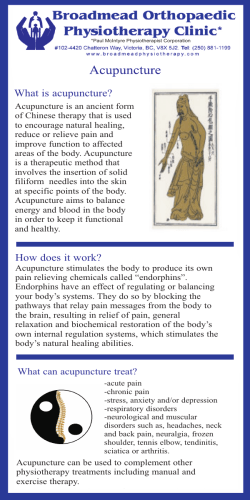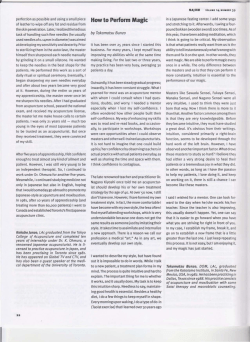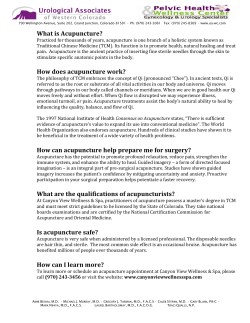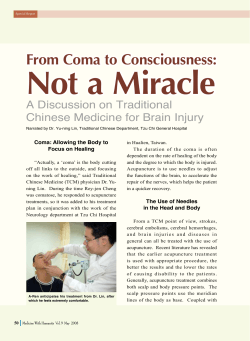
JMBE-Journal of Medical and Biological Engineering
Journal of Medical and Biological Engineering, 25(1): 21-25 21 The Treatment of Upper Back Pain by Two Modulated Frequency Modes of Acupuncture-like TENS Ching-Sung Weng1,2,* Yuh-Show Tsai1 Chun-Chung Chen1 Shen-Hwa Shu1 Mao-Feng Sun3 1 Department of Biomedical Engineering, Chung Yuan Christian University, Chungli, Taiwan, 320, ROC 2 Chinese Medical Engineering Center, Chung Yuan Christian University, Chungli, Taiwan, 320, ROC 3 Department of Acupuncture, Chang Gung Memorial Hospital, Tao-Yuan, Taiwan, 333, ROC Received 3 Mar 2005; Accepted 26 Mar 2005 Abstract The aim of this research was to evaluate the treatment effect of two modulated-frequency mode of acupuncture-like transcutaneous electrical nerve stimulation (AL-TENS) on patients with upper back pain. Thirty patients suffering from upper back pain for at least three months were involved in the study from Chung Yuan Christian University. The subjects were randomly assigned to three treatment groups in different time slots as repeated measures design. Each group (n=30) was respectively treated with either 5 KHz modulated by 2 Hz frequency mode (LF group), 5 KHz modulated by 100 Hz frequency mode of TENS (HF group) on acupuncture points (GB21) located in the upper back area, or sham TENS (control group). Two electrodes were placed on right and left acupoints. The intensity of stimulation was adjusted at a tolerable level for each subject. Patients were treated for twenty minutes per visit, three times a week for two weeks. Visual analog scale (VAS) was used to rank the degree of pain before and two weeks after the treatment. A device, the design of which is based on the Ryodoraku theorem, was used to measure the electrical conductance of 12 meridians and the acupoint (GB21) on both sides of the subjects. The results showed that: (1) after the AL-TENS treatment in this study, the electrical conductances of either meridians or acupuncture points increased with the decrease of VAS of the patients; the correlation was higher in the acupoints than that in the meridians; (2) the effect of AL-TENS on the percentage change of VAS is more related to the percentage change of electrical conductances of acupoints than that of meridians; (3) 5 KHz modulated by 2 Hz or 100Hz frequency mode of AL-TENS was effective in the treatment of the patients with upper back pain. Keywords: Upper back pain, Visual analog scale, Electrical conductance, Meridian, Acupuncture point Introduction Back pain is a cause of much suffering, disability and consumption of resources [1]. Especially, upper back pain is usually caused from over-loaded working, long-term sitting-and-typing, or heavy excising. Pain is a common health problem in the world. Numerous treatments, such as, conventional physiotherapy, corticosteroid, surgery, transcutaneous electrical nerve stimulation (TENS), acupuncture-like transcutaneous electrical nerve stimulation (AL-TENS), percutaneous electrical nerve stimulation (PENS), acupuncture, and electro-acupuncture (EA) are available for pain or upper back pain. TENS has most frequently been used for chronic pain [2, 3]. The reason why TENS has a modulating effect on pain is that it is associated with blocked nociceptive transmission in the spinal cord [4, 5]. The * Corresponding author: Ching-Sung Weng Tel: +886-3-2654545; Fax: +886-3-2654599 E-mail: [email protected] technique of AL-TENS, application of TENS on acupuncture points, was also found pain-alleviating. The pain modulation of AL-TENS is associated with endorphin, which is released in response to afferent activity in the A delta fibers [6]. The modulating effect is usually activated by electrical stimulation with intensities as high as the patient can tolerate [7]. However, low and high intensities have been used in TENS and AL-TENS, respectively [8, 9]. Another important parameter of electrical stimulation is “frequency”. Low frequency (2 Hz, 4 Hz) and high frequency (50, 80, 100, 110 Hz) have been used in TENS, AL-TENS, PENS, or EA for the study of pain [10-15]. Medium frequency from 1 KHz to 15 KHz has been studied for pain threshold and nerve excitation [16-18]. Also, the frequency of 2 KHz and 5 KHz has been evaluated on its antinociceptic effect [19]. It seems that there is no clear line to say which frequency is better and what intensity is good. Moreover, the site of stimulation is very critical for the outcome of treatment. Previous studies have shown that J. Med. Biol. Eng., Vol. 25. No. 1 2005 22 stimulation on acupuncture points is more effective than that on dermatomal and/or segmental areas [6, 20]. It implies that AL-TENS could be better than TENS with the same condition of electrical parameters. Similarly, EA could be better than PENS. The evaluation of the treatment effect on pain is also an important issue. Usually, the degree of pain can be evaluated by “visual analogue scale” (VAS) as well as by many other pain ranking methods. However VAS is a very subjective and qualitative method to evaluate pain. A more objective and quantitative method is needed. Earlier studies have shown that human health condition and diseases can be evaluated by the electrical conductance or impedance (inverse of conductance) of acupuncture points or meridians using the Ryodoraku technique [21-23]. Based on the Ryodoraku (meridian) theory, developed by Dr. Yoshio Nakatani [24], there are 12 meridians on the right and left sides of the human body. The property of ryodoraku can reflect the condition of certain organ(s) by analyzing and comparing their mutual relations and changes with micro electrical current. The electrical state of the acupuncture points of the human subject is measured by a computerized testing instrument with a very low electrical current. From the traditional theory, Ryodoraku is a pathological phenomenon. The mechanism can be explained by the viscera-skin sympathetic nerve reflex. The impulses from the viscera radiate to the spinal cord. The reflex zones are then reflected onto the skin surface via the efferent sympathetic nerves and appear as a longitudinal connecting system, just like meridian lines. It has been shown that meridians and acupuncture points have higher electrical conductance than other areas [21, 25-27]. Many studies have provided the mapping transforms between the electrical information given by Ryodoraku diagnosis and the patterns associated with various medical syndromes, signs, symptoms, and diseases. However, no research concerning the application of Ryodoraku theory in the diagnosis of pain has been reported. Based on the theory, the electrical conductances of meridians and acupoints as well as the VAS pain score in the patients with upper back pain were investigated in this paper. Also, the treatment effects of two modulated frequency modes of AL-TENS on pain were evaluated. Methods Subjects Thirty male patients with upper back pain for at least three months were recruited in the study from Chung Yuan Christian University. All the subjects, clinically evaluated by a doctor, were in the ages between 20 and 30 years old. Subjects, who had a history of cardiovascular disease, liver disease, kidney disease, other organ diseases, and/or complaints of pain in the areas other than elbow, were excluded. Patients, with problems in the care of the electrical stimulation and with skin allergic to electrodes, were also not involved in the study. TENS procedure Thirty subjects were randomly assigned to three treatment groups in different time slots as repeated measures design. Each group (n=30) was respectively treated with either 5 KHz modulated by 2 Hz frequency mode (LF group), 5 KHz modulated by 100 Hz frequency mode of TENS (HF group) on acupuncture point (GB21), or sham TENS (control group). The TENS device used in this study is just like other TENS. The only difference is that there are many frequency modes including single and modulated frequency to choose from. Two rubber electrodes (2 cm in diameter) were placed on two acupoints on the subject’s right and left sides of upper back. Pulse duration of electrical stimulation was fixed at 0.1 ms. The intensity of stimulation was adjusted at a tolerable level for each subject. Patients were treated for twenty minutes per visit, three times a week for two weeks. Each treatment was performed by the same researcher. Measurements The degree of pain of all the subjects was evaluated with visual analog scale (0-no pain, 10-the worst pain the patient had ever experienced) by the same researcher before and after treatment. The electrical conductances of 24 acupuncture points (Ryodoraku points) in the twelve left meridians and the twelve right meridians were measured with a device (C.Y. Biotech, with Taiwan’s Patent), the design of which is based on the Ryodoraku theory. This device has been used in previous studies [28-30]. Also, the electrical conductances of the acupuncture point (GB21) on both sides of the upper back pain area were measured. Before measuring, the device was well calibrated to assure its reproducibility. Each time of measurement was taken by the same research assistant to avoid human artifact error. All the measurements were recorded on a data base in the computer which controls the measuring device. The room temperature was kept between 22 and 26 oC and the humidity was kept constant by air conditioning. Readings of electrical conductance were recorded from both groups before and two weeks after treatment procedure. The conductance values were calculated with voltage supplied by the device and currents measured in meridians or acupuncture points and expressed as the scale between 0 (zero conductivity) and 100 (maximum conductivity). The mean conductance value of 24 meridians in each subject was calculated. Also, the mean conductance value of two acupoints (GB21) in each subject was calculated. The average and standard error of such values (n=30 in each group) were then determined and expressed as “Mean±SEM” for later statistical analysis. Statistical analysis The scores of VAS in each group before and after the treatment were compared with non-parametric Wilcoxon’s signed-rank test. The percentage changes of VAS scores in three groups were calculated for comparison of group treatment effect and were analyzed by non-parametric Kruskal Wallis test. The difference between the conductance values (Mean±SEM) of patients in each group measured before and after the AL-TENS procedure was analyzed by paired t test. An independent one-way analysis of variance (ANOVA) test was performed to evaluate the difference between the percentage changes of conductance values of three groups. A statistical significance was recognized as p-value<0.05. AL-TENS on Upper Back Pain Table 1. Visual analog scale (VAS) pain scores (Mean±SD) in patients before and after two modulated frequency modes of AL-TENS treatment Frequency Mode VAS Control before after 4.40±2.09 4.30±2.07 LF before after 4.46±1.85 a 3.81±1.70 HF before after 4.10±2.09 a 3.49±1.70 24 Meridians b Control 0.04±6.13 LF 3.76±20.95 a a HF 24 Meridians 2 Acupoints 72.13±8.64 73.71±7.68 Control before after 54.93±7.21 54.89±7.22 LF before after 54.79±7.35 a 57.33±8.55 HF before after 52.89±9.35 c 58.39±9.03 a c 6.14±24.54 a a,b 2 Acupoints 2.91±11.34 a,c 12.67±12.24 8.45±10.56 a c * a: p<0.05; b: p<0.05; c: p<0.01 Table 2. Electrical conductances (Mean±SEM) of meridians and acupoints in patients before and after two modulated frequency modes of AL-TENS treatment b 70.50±7.14 b 77.81±9.45 difference between LF and control groups as well as between HF and control groups (p<0.05). As shown in Table 4, there was no statistical difference in the percentage changes of electrical conductances of meridians between LF and control groups, but there was a significant difference between LF and HF groups as well as between HF and control groups (p<0.05). Whilst, there was a statistical difference in the percentage changes of electrical conductances of two acupoints between three groups, and this was highest in the HF group (p<0.05). d 73.53±9.63 d 78.58±7.28 * a, c: p<0.01; b, d: p<0.05 Table 3. Percentage change of the visual analogue scale (VAS) pain scores in patients before and after AL-TENS treatment Frequency Mode Table 4. Percentage change (%) of the electrical conductances of meridians and acupoints in patients before and after AL-TENS treatment Frequency Mode * a: p<0.05 Frequency Mode 23 % change of VAS a,b Control -1.88±5.78 LF -16.11±15.73 HF -13.32±14.74 a b * a: p<0.05; b: p<0.05 Results Thirty patients with upper back pain, in the ages between 20 and 30 years old with a mean age of 25.3±5.1 years, were recruited in this study. As shown in Table 1, there was a significant difference of VAS either in LF or HF group before and after treatment (p<0.05); whilst the difference of VAS was not significant in the control group. As shown in Table 2, there was no significant difference of electrical conductance of the 24 meridians in either LF or control group but significant in the HF group before and after treatment (p<0.05); Whilst, there was a significant difference of electrical conductance of two acupoints in each treatment group before and after treatment (p<0.01). As shown in Table 3, there was no statistical difference in the percentage changes of VAS scores between LF and HF groups, but there was a significant Discussion The aim of this research was to evaluate the treatment effect of two different modulated frequency modes of acupuncture-like TENS on patients with upper back pain. In our previous research [28-30], healthy control and sham control as well as 2 Hz/100Hz frequency modes of TENS without modulated frequency of 5 KHz had been studied. The data from previous studies showed that there was no significant difference in electrical conductances of meridians or acupoints before and after treatment. From the results of this study, VAS pain score indicated that these two modulated frequency modes of AL-TENS were effective on the treatment of upper back pain. Unlike the frequency mode used in our study, a mixed frequency (an alternating frequency between 2 and 100 Hz) has been applied in previous studies [6, 31, 32]. Electrical stimulation with a mixed frequency had proved most effective in their investigation. Important to our study in the treatment of upper back pain was the use of modulated frequency of AL-TENS and the evaluation of pain with electrical conductances of meridians and acupuncture points. Stimulation of TENS on acupuncture points changes the electrical conductance of meridians and acupuncture points, and regulates the central nervous system (CNS). The regulation of the human health condition can be likened to the regulation of homeostatically controlled variables, such as bioelectricity or bio-energy. Being homeostatic, mammals are able to maintain relatively constant internal parameters in the face of variable and often extreme ambient changes. This fact is easily accomplished by means of coupled afferent and efferent mechanisms. Sensory receptors in the skin, muscle, nerve, organ, and elsewhere continuously send messages (such as electrical impulses) to the CNS. The CNS in turn combines 24 J. Med. Biol. Eng., Vol. 25. No. 1 2005 this information with other relevant information (activity level, needs of various tissues, cognitive information) and adjusts the gain of some subset of possible effect or mechanism (pain in local area, blood flow in superficial veins, breathing rate, perspiration, etc). The result is that the abnormal condition such as body pain can be accomplished via adjustments in both body fluid (including blood) regulation and autonomic responses. To our knowledge, the role of the brain (especially the hypothalamus) in the regulation of energy or health condition is well established in animals. In humans, substantial molecular and neuropharmacologic evidence attest to the importance of the central nervous system in maintaining an energy balance. The basic promise of energy medicine is that energetic processes, including electrical and magnectic processes, vibrational resonance, and bio-photon emission, are essential to the life process. Bio-energy functions are carrier of “bio-information” and are crucial to biological self-regulation [33]. Bio-energy has been studied, by measuring the electrical conductances of meridians and/or acupuncture points, in healthy and diseased people [34, 35]. Therefore, the central nervous system plays an important role in the regulation of bio-energy as well as the meridian system. The pathogenesis of pain has been suggested to be intimately linked to the regulation of the sympathetic nervous system. Excitation of a sympathetic response may alter the afferent input to the CNS and evoke analgesic effect [36]. TENS can usually affect peripheral conduction, excite the sympathetic nerve, and mediate hypoalgesia [37], while AL-TENS has an even stronger effect on the conductance of meridian system. This is besides its effect on the CNS. Many earlier studies have shown that the nervous system is somewhat related to the meridian system. Usually, needles, heat, or electrical stimulation on acupuncture points can give rise to nervous impulses and regulate the body or organ functions. A good body function often has a nice conductivity of heat or electrical energy. Our study demonstrated that the measurement of meridian electrical conductance could be a way to evaluate how the meridian (even the nervous system) is regulated before and after the AL-TENS treatment. As the results showed, electrical conductance of meridian or acupuncture point increased when the level of pain was claimed to decrease in patients with upper back pain. Patients with upper back pain frequently suffer from tiredness and lack of strength in the upper back area as the subjects in the study. Tiredness or lack of strength is one of the symptoms of qi vacuity syndrome which is correlated to the decrease of skin conductance [38]. Although the device they used is based on Dr. Voll’s research [39], the skin conductance they measured is still related to the meridian conductance measured on the skin surface of the acupuncture point in our study. In that case, skin electrical resistance, skin moisturization, and sub-skin tissue water content can be important when taking the measurement. The water content of stratum corneum, which in turn is influenced by sweat gland function, influences skin resistance. The sweat gland is a target organ of the peripheral autonomic system. By measuring the electrical conductance of the skin over acupuncture point, the function of the peripheral autonomic system could be measured on a digital scale [40]. Sweat glands are innervated by cholinergic fibers. Increased intradermal acetylcholine causes the secretion of sweat glands, which in turn leads to an increase of skin conductance and decrease of skin electrical resistance. By measuring (regional) skin resistance, the function of peripheral (regional) autonomic innervation can be evaluated indirectly [41, 42]. Moreover, the distribution of the intradermal cholinergic fibers is not always the same. This provides the reason why the electrical conductances measured in this research were different (i.e., the standard deviation of mean of meridian electrical conductance) in the twelve meridians of the same subject. The patient with upper back pain usually has a weak sympathetic nervous pulse in some meridian regions and also showed the worse conductance. This is the major reason why the variation of conductance was higher in the group especially with more variation of pain score (original data not shown). Also, the intensity of stimulation adjusted at a tolerable level for each subject was varied in a narrow range from subject to subject. It did not significantly affect the observed electrical conductance. The electrical conductance of the subject was not correlated to his age as well. Furthermore, the electrical conductances of either meridians or acupuncture points increased with the decrease of VAS of the patients after the treatment by AL-TENS especially with 5 KHz modulated by 100 Hz frequency. The results also demonstrated that the reason for the increase of electrical conductance could be the soothing of nerve and muscle and improving of local blood circulation in the deep tissue which were stimulated by the frequency of 5 KHz [16-19]; whilst the decrease of VAS was the analgesic effect caused by the frequency of either 2 Hz or 100 Hz [10, 30]. Conclusion In summary, the findings in this paper suggest that acupuncture-like TENS with modulated frequency may be a good treatment choice for patients with upper back pain. Also, the electrical conductance of acupoints in the area of pain may be used to objectively and quantitatively evaluate the degree of pain other than by using a subjective and qualitative pain score. References [1] [2] [3] [4] [5] D.J. Grant, J. Bishop-Miller, D.M. Winchester, M. Anderson, S. Faulkner, “A randomized comparative trial of acupuncture versus transcutaneous electrical stimulation for chronic back pain in the elderly,” Pain 82: 9-13, 1999. M.R. Gersh, S.L. Wolf, “Application of transcutaneous electrical nerve stimulation in the management of patients with pain: state of-the-art update,” Phys. Ther., 65: 314-322, 1985. J.S. Mannheimer, G.N. Lampe, Clinical transcutaneous electrical nerve stimulation, Philadelphia: FA Davis, 1984. D.W. Garrison, R.D. Foreman, “Effects of transcutaneous electrical nerve stimulation (TENS) on spontaneous and noxiously evoked dorsal horn cell activity in cats with transected spinal cords,” Neurosci. Lett., 216: 125-128, 1996. R. Melzack, P.D. Wall, “Pain mechanisms: a new theory,” AL-TENS on Upper Back Pain [6] [7] [8] [9] [10] [11] [12] [13] [14] [15] [16] [17] [18] [19] [20] [21] [22] [23] Science, 150: 971-979, 1965. L. Chen, J. Tang, P.F. White, A. Sloninsky, R.H. Wender, R. Naruse, R. Kariger, “The effect of location of transcutaneous electrical nerve stimulation on post-operative opioid analgesic requirement: acupoint versus nonacupoint stimulation,” Anesth. Analg. 87: 1129-1134, 1998. M.C. Bushnell, S. Marchand, N. Tremblay, G.H. Duncan, “Electrical stimulation of peripheral and central pathways for the relief of musculoskeletal pain,” Can. J. Physiol. Pharmacol. 69: 697-703, 1991. D.M. Walsh, TENS clinical applications and related theory, New York, NY:Churchill Livingstone, 1997. D.M. Walsh, G.D. Baxter, “Transcutaneous electrical nerve stimulation (TENS): a review of experimental studies,” Eur. J. Phys. Med. Rehabil., 6: 41-51, 1996. L.S. Chesterton, P. Barlas, N.E. Foster, T. Lundeberg, C.C. Wright, G.D. Baxter, “Sensory stimulation (TENS): effects of parameter manipulation on mechanical pain thresholds in healthy human subjects,” Pain, 99: 253-262, 2002. J.G. Lin, M.W. Lo, Y.R. Wen, C.L. Hsieh, S.K. Tsai, W.Z. Sun, “The effect of high and low frequency electroacupuncture in pain after lower abdominal surgery,” Pain, 99: 509-514, 2002. M. Oncel, S. Sencan, H. Yildiz, N. Kurt, “Transcutaneous electrical nerve stimulation for pain management in patients with uncomplicated minor rib fractures,” Eur. J. Car. Surg., 22: 13-17, 2002. E.A. Ghoname, P.F. White, H.E. Ahmed, M.A. Hamza, W.F. Craig, C.E. Noe, “Percutaneous electrical nerve stimulation: an alternative to TENS in the management of sciatica,” Pain, 83: 193-199, 1999. D.J. Grant, J. Bishop-Miller, D.M. Winchester, M. Anderson, S. Faulkner, “A randomized comparative trial of acupuncture versus transcutaneous electrical nerve stimulation for chronic back pain in the elderly,” Pain, 82: 9-13, 1999. K.A. Sluka, K. Bailey, J. Bogush, R. Olson, A. Ricketts, “Treatment with either high or low frequency TENS reduces the secondary hyperalgesia observed after injection of kaolin and carrageenan into the knee joint,” Pain, 77: 97-102, 1998. A.R. Ward, V.J. Robertson, “Sensory, motor and pain thresholds for stimulation with medium frequency alternating current,” Arch. Phys. Med. Rehabil. 79(3): 273-278, 1998. A.R. Ward, V.J. Robertson, “Variation in torque production with medium frequency alternating current,” Arch. Phys. Med. Rehabil. 79(11): 1399-1404, 1998. S.T. Palmer, D.J. Martin, W.M. Steedman, J. Ravey, “Alternation of interferential current and transcutaneous electrical nerve stimulation frequency: effects on nerve excitation,” Arch. Phys. Med. Rehabil. vol. 80(9): 1065-1071, 1999. J.G. Lin, X.H. Chen, J.S. Han, “Antinocicetion produced by 2 and 5 KHz peripheral stimulation in the rat,” Int. J. Neurosci. 64: 15-22, 1992. C. Takeshige, T. Sato, T. Mera, T. Hisamitsu, J. Fang, “Descending pain inhibitory system involved in acupuncture analgesia,” Brain Res. Bull., 29: 617-634, 1992. K.G. Chen, “Electrical properties of meridians: with an overview of the electrodermal screening test,” IEEE Eng. Med. Biol. Mag. 3: 58-63, 1996. S.G. Sullivan, D.W. Eggleston, J.T. Martinoff, R.J. Kroening, “Evoked electrical conductivity on the lung acupuncture points in the healthy individuals and confirmed lung cancer patients,” Am. J. Acupunct., 13: 63-68, 1985. R.Q. Becker, M. Reiochmanis, A. Marino, “Electrophysiological correlates of acupuncture points and meridians,” Psychoenergetic Systems., 1(106): 195-212, 1976. [24] [25] [26] [27] [28] [29] [30] [31] [32] [33] [34] [35] [36] [37] [38] [39] [40] [41] [42] 25 Y. Nakatani, “Skin electric resistance and ryodoraku,” J. Autonomic Nerve, 6: 52, 1956. F. Jingyu, X. Shiyuan, L. Zhe, W. Zhemei, “The role of gap junctions in determining skin conductance and their possible relationship to acupuncture points and meridians,” Am. J. Acupunct., 18: 163-170, 1990. M. Reichmanis, A. Andrew, R.Q. Becker, “DC skin conductance variation at acupuncture loci,” Am. J. Chin. Med., 4: 69-72, 1976. Z.X. Zhu, “Research advances in the electrical specificity of meridians and acupuncture points,” Am. J. Acupuncture, 9: 203-216, 1981. C.N. Wang, C.S. Weng, W.C. Hu, Y.H. Chang, J.G. Lin, “The development of new ryodoraku neurometric patterns,” J. Med. Bio. Eng., 22(S): s99-s106, 2002 (In Chinese). C.S. Weng, C.N. Wang, W.C. Hu, M.F. Sun, “Evaluation of acupuncture treatment of low back pain using a new ryodoraku neurometric system,” J. Chin. Med. Sci., 3(1): 65-72, 2002 (In Chinese). C.S. Weng, Y.S. Tsai, C.Y. Yang, “Using electrical conductance as the evaluation parameter of pain in patients with low back pain treated by acupuncture-like TENS,” Biomed. Eng. Appl. Basis. Comm. 16: 205-212, 2004. M.A. Hamza, P.F. White, H.E. Ahmed, E.A. Ghoname, “Effect of the frequency of transcutaneous electrical nerve stimulation on the post-operative opioid analgesic requirement and recovery profile,” Anesthesiology, 91: 1232-1238, 1999. B. Wang, J. Tang, P.F. White, R. Naruse, A. Sloninsky, R. Kariger, J. Gold, R.H. Wender, “Effect of the intensity of transcutaneous acupoint electrical stimulation on the post-operative analgesic requirement,” Anesth. Analg., 85: 406-413, 1997. J.J. Tsuei, “The science of acupuncture: theory and practice,” IEEE Eng. Med. Biol. Mag., 3: 52-57, 1996. J.J. Tusei, C. Chung, F. Lam, Jr, M. Mi, “Studies of bioenergy in healthy subjects,” Am. J. Acupunct., 16: 125-134, 1988. F. Lam, Jr, J.J. Tsuei, Z. Zhao, “Studies on the bioenergetic measurement of acupuncture points for determination of correct dosage of allopathic or homeopathic medicine in the treatment of diabetes mellitus,” Am. J. Acupunct., 18: 127-133, 1990. W.D. Willis, K.N. Westlund, “Neuroanatomy of the pain system and of the pathways that modulate pain,” J. Clin. Neurophysiol., 14: 2-31, 1997. [37] D.M. Walsh, A.S. Lowe, K. McCormack, J.C. Willer, G.D. Baxter, J.M. Allen, “Transcutaneous electrical nerve stimulation: effect on peripheral nerve conduction, mechanical pain threshold, and tactile threshold in humans,” Arch. Phys. Med. Rehabil., 79: 1051-1058, 1998. H.M. Yu, H.H. Chang, S.H. Liou, S.F. Li, M.M. Hou, M.F. Chen, “The correlation between skin electrical conductance and the score of qi vacuity,” Am. J. Chin. Med. 26 (3-4): 283-290, 1998. R. Voll, “The phenomenon of medicine testing in electroacupuncture according to Voll,”. Am. J. Acupunct., 8: 97-104, 1980. Y. Yamamoto, “Measurement and analysis of skin electrical impedance,” Acta. Derm. Venerol.(stockh), 185: 34-8, supp. 1994. R.E. Ryder, R.L. Kennedy, P.G. Newrick, “Autonomic denervation may be a prerequistite diabetic neuropathic foot ulceration,” Diabet. Med. 7: 726-730, 1990. H. Tagami, “Quantitative measurements of water concentration of the stratum corneum in vivo by high frequency current,” Acta. Derm. Venerol.(stockh), 185: 29-33, supp 1994.
© Copyright 2026









